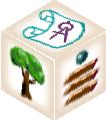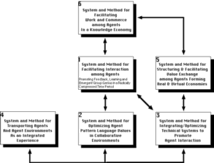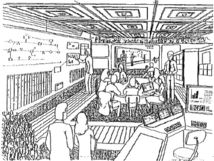| c o n f i d e n t i a l Privileged access only
|
|
This document uses a custom font for the Glyphical Language part of this Patent.
|
| SYSTEM AND METHOD FOR AUGMENTING KNOWLEDGE COMMERCE Overview and Background of the Invention History of the Patent Application
|
FIELD OF THE INVENTION
The present Invention broadly relates to a system and method for addressing the paradoxes, problems and opportunities associated with the Knowledge Economy, and the transition to it. The System and Method of the present Invention create a unified experience of work that scales from the level of individual thought processes (and their component aspects) to the building and using of a global system of commerce. Described in several levels of recursion, the System and Method of the present Invention integrate, into a single system several discrete Subsystems and methods that comprise a myriad of now unintegrated tools and processes that are conducted, today, across contradictory, partially communicating and non-collaborative environments.
Summary of the invention
BACKGROUND OF THE INVENTION
 It is now widely understood that we are in the midst of a global transformation from a manufacturing society to an information based society, i.e. Knowledge Economy ToA or Net Work economy ToA. As our society makes the transition to this new economy, we must have set in place new ways of working that will be fundamentally different from those we have experienced in the last 100 years. These new ways of working will demand that we view Agents ToA, whether individual humans, machines, groups or organizations, as the economy’s most important resource and resource creator, the resource that moves and creates information and designs artifacts ToA and solutions ToA.
It is now widely understood that we are in the midst of a global transformation from a manufacturing society to an information based society, i.e. Knowledge Economy ToA or Net Work economy ToA. As our society makes the transition to this new economy, we must have set in place new ways of working that will be fundamentally different from those we have experienced in the last 100 years. These new ways of working will demand that we view Agents ToA, whether individual humans, machines, groups or organizations, as the economy’s most important resource and resource creator, the resource that moves and creates information and designs artifacts ToA and solutions ToA.
Unlike most natural resources ToA, intelligent ToA Agents and the knowledge they produce have unlimited potential. Unlike most natural resources, these resource are not “lost” when spent and tend to increase in value through use. We, as a society, have only begun to find ways to effectively, measure, account, tap and nurture this potential for new knowledge ToA. This knowledge will affect everything we do, from tilling the land, to manufacturing vehicles for transportation, to the delivery of education, health and other services. It will redefine our understanding of work itself, as well as, the very nature of our economy. Our investment in Intellectual Capital ToA and how we organize and manage it will be the key to our society’s productivity and growth. Indeed, it may be the key issue in determining if our society can continue to exist at anything near its current level of wealth which, in its present form, is created and used by means that are not sustainable over any significant period of time. If we accept and successfully meet the challenge of this window of opportunity ToA, we can experience unprecedented growth and development in the quality of life supported by this society. If we refuse to see the need for this transition, or fail to meet its challenge, we are doomed to decline, not just in power, but in our quality of life.
 The nature of the problems that Humankind faces are different than those of prior generations. Problems that are socially significant, offer great opportunity or danger and relate directly to the emerging Knowledge/ Net Work Economy are systemic in nature. These problems do not yield to the kinds of approaches characteristic of simple problems. An example of a systemic problem ToA is a river running through three states, 8 counties and 14 cities. Who owns it, controls it, pollutes it and stewards it? Equally, a systemic problem can be described as a weapon system used by multiple services and countries, deployed globally and employing 40,000 people world-wide in its creation use and support. Systemic problems cannot be solved (without harmful unintended consequences) in a linear fashion from a “parts” perspective using simple tools. Systemic (complex) problems cannot be solved (dissolved) based on definitions formed in a language ToA not able to describe them. Complex solutions cannot be implemented by inadequately adaptive organizations transacting business with financial tools that are cumbersome, based on the structure of a prior economy, ambiguous and lacking sufficient complexity (Requisite Variety Problem).
The nature of the problems that Humankind faces are different than those of prior generations. Problems that are socially significant, offer great opportunity or danger and relate directly to the emerging Knowledge/ Net Work Economy are systemic in nature. These problems do not yield to the kinds of approaches characteristic of simple problems. An example of a systemic problem ToA is a river running through three states, 8 counties and 14 cities. Who owns it, controls it, pollutes it and stewards it? Equally, a systemic problem can be described as a weapon system used by multiple services and countries, deployed globally and employing 40,000 people world-wide in its creation use and support. Systemic problems cannot be solved (without harmful unintended consequences) in a linear fashion from a “parts” perspective using simple tools. Systemic (complex) problems cannot be solved (dissolved) based on definitions formed in a language ToA not able to describe them. Complex solutions cannot be implemented by inadequately adaptive organizations transacting business with financial tools that are cumbersome, based on the structure of a prior economy, ambiguous and lacking sufficient complexity (Requisite Variety Problem).
Systemic problems are by definition complex. Complexity drives variety. High variety, complex systems, by definition, cannot be understood nor are they amenable to traditional “command and control” kinds of governance Complex systems EMERGE and co-evolve with their environments. They represent a fundamentally different kind of phenomena than simple systems.
The economic shift from an Industrial Economy to a Knowledge Economy has been the subject of a tremendous amount of discussion and commentary in business and political literature. Among other things, it is widely recognized that this Economic Shift creates both opportunities, challenges, problems and paradoxes.
What is lacking is a framework ToA for systematically and methodically addressing the paradoxes and problems associated with the Knowledge/Network Economy and the transition to it. While there is no known system ToA and method for augmenting ToA knowledge commerce, there have been attempts to address discrete parts that relate to the augmentation and facilitation ToA of knowledge commerce ToA.
In this context, the background relating to the principal Sub-Systems of the present invention will now be discussed.
For ease of understanding, the system of the present invention will be described as including six discrete Subsystems which are linked, connected and integrated in myriad ways at many levels of recursion. The six Subsystems of the present invention may be summarized as follows:
Subsystem 1
System and Method for Facilitating Interaction among Agents - Promoting Feedback, Learning and Emergent Group Genius in a Radically Compressed Time Period
AGENT INTERACTION Dissolves many problems of numerous Agents (Humans, computers, books, data bases, environmental and infrastructure elements, multimedia objects, etc.) speaking in non-compatible voices while interacting to solve complex problems associated with the necessity to stay requisite with a quickly changing and transforming environment and economy. Dissolves numerous blocks to the systematic emergence of synergy among Agents.
Subsystem 2
System and Method for Optimizing Agent Pattern Language Values in Collaborative Environments
AGENT ENVIRONMENTS Dissolves many problems of Human (and other Agents) Architectural Pattern Language Values while accomplishing flexibility of arrangement (from workstation component level to building scale), the variety of individual and work spaces necessary for the full range of knowledge-intensive work (including collaboration of different size groups), the integration of multimedia and communication tools, yet, accomplishing and greater utilization of space and utilities than existing systems. Dissolves numerous block to the timely and economic management of these environments.
Subsystem 3
System and Method for Integrating/Optimizing Technical Systems to Promote Agent Interaction
AGENT SYSTEMS Dissolves many problems of knowledge-augmentation by technical systems and tools for single Agent work and the collaborative interaction of Agents, both real time and asynchronously, through multi-channel and multimedia networks and tool sets. Dissolves numerous blocks to the systematic creation, testing and employment of Agents of many kinds.
Subsystem 4
System and Method for Transporting Agents and Agent Environments as an integrated Experience
AGENT TRANSPORTATION Dissolves many problems of seamless and integrated Agent (and agent environments) transportation providing a continuity of work and experience required by the demands of a global economy. Dissolves numerous blocks related to supply chain integration, RemotePresence, RemoteCollaboration and RemoteManufacturing.
Subsystem 5
System and Method for Structuring and Facilitating Value Exchange among Agents Forming Real and Virtual Economies
AGENT ECONOMY Dissolves many issues of facilitating knowledge-economy Transactions and Agent value accounting while radically reducing the multiplicity of financial instruments (in a myriad of legal environments) now systemic to the industrial-based economy. Dissolves many problems associated with the evaluation of intangible assets. Dissolves many problems associated with the failure of existing “instruments and processes of execution” to accomplish the cycle-time (ToA), fine-graininess, ubiquity and scale-of-use required by the emerging Knowledge/Network Economy (ToA) - today, “ v does not equal V” (RS).
Subsystem 6
System and Method for Facilitating Work and Commerce among Agents in a Knowledge Economy
AGENT WORK AND COMMERCE Dissolves many problems of Agent participation in a Complex Global Economy and the TRANSITION to it. Dissolves many problems related to the incremental use of new capacities that, lacking appropriate built-in feedback, can actually damage the economic system that “hosts” them.
THE SYSTEM AND METHOD AS A SYSTEM
In accordance with the present invention, however, all of these Subsystems INTEGRATE into a single system and method-of-work that facilitates a seamless, continuity of effort and high-performance results across what are now partially connected systems, (at different and, often, non-communicating levels of recursion), now delivering a fragmented, expensive and lengthy experience that is not requisite with the existing (let alone future) complexity and rate-of-change in the global economic environment. Further, these existing levels of recursion embody few means for systematic governance, the creation of memory nor conversant languages.
Return to Outline

SolutionBox voice of this document:
IDENTITY • STRATEGY • CONTRACT DOCUMENTS
posted May 26, 2000
revised October 26, 2001
• 20000526.120717.mt • 20000616.145356.mt • 20000623.73645.mt •
• 20000628.151916.mt • 20011026.298120.mt •
(note: this document is about 70% finished)
Copyright© 1982, 1997, 1998, 1999, 2000, 2001 Matt Taylor
Contact:
Matt Taylor650 814 1192

